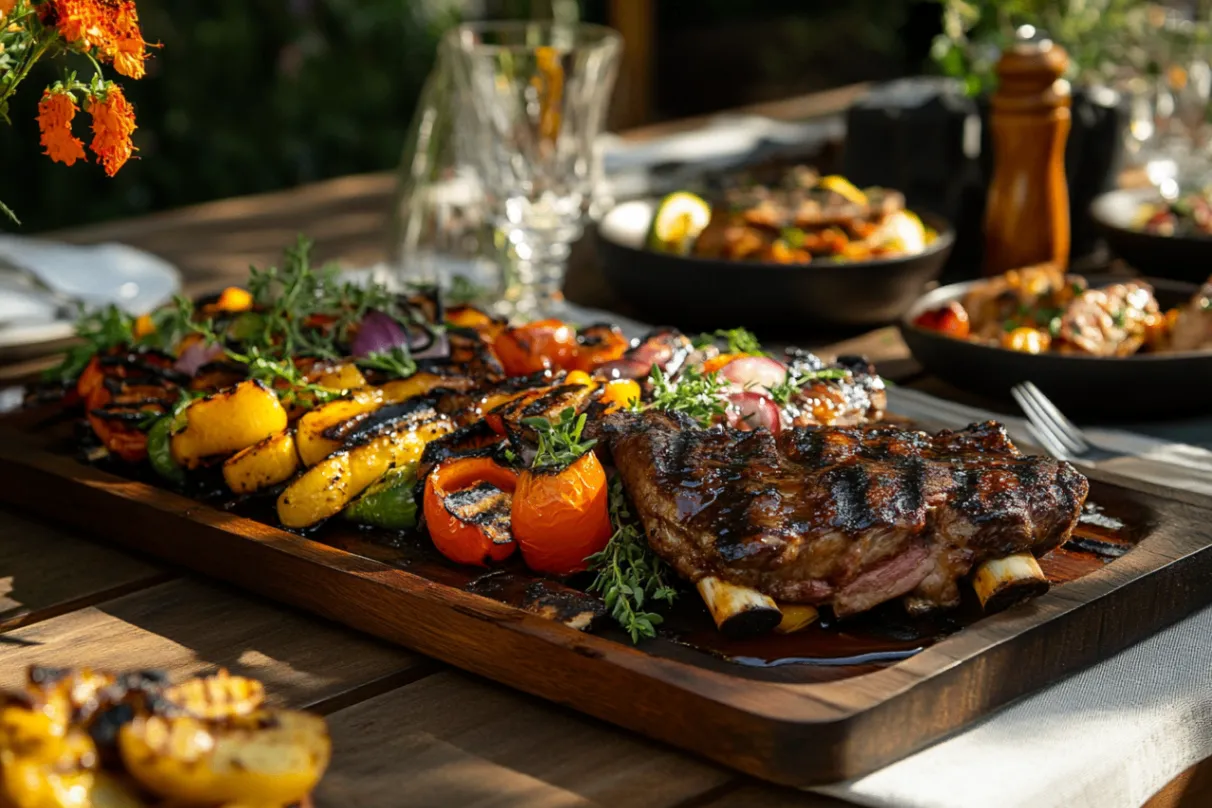Table of Contents
Table of Contents
Introduction: Transform Your Backyard into a Culinary Paradise
There’s something magical about the sizzle of meat hitting hot grill grates, the aromatic smoke dancing through the air, and the joy of gathering friends and family around a perfectly prepared barbecue feast. Whether you’re a weekend warrior looking to master your backyard setup or a seasoned grilling enthusiast seeking to elevate your BBQ game, this comprehensive guide will transform your outdoor cooking experience from ordinary to extraordinary.
Grilling isn’t just about cooking food—it’s about creating memories, fostering connections, and celebrating the timeless tradition of gathering around fire. From selecting the perfect cuts of meat to mastering temperature control, from understanding the nuances of different grilling techniques to creating an atmosphere that brings people together, we’ll cover everything you need to know to host unforgettable BBQ gatherings that will have your guests talking long after the last ember has cooled.
In this ultimate grilling guide, you’ll discover professional techniques used by pitmasters, learn how to choose and prepare the best ingredients for maximum flavor, and gain insider tips that will elevate every aspect of your grilling experience. Whether you’re planning an intimate family dinner or a large backyard celebration, these strategies will ensure your BBQ becomes the highlight of any gathering.
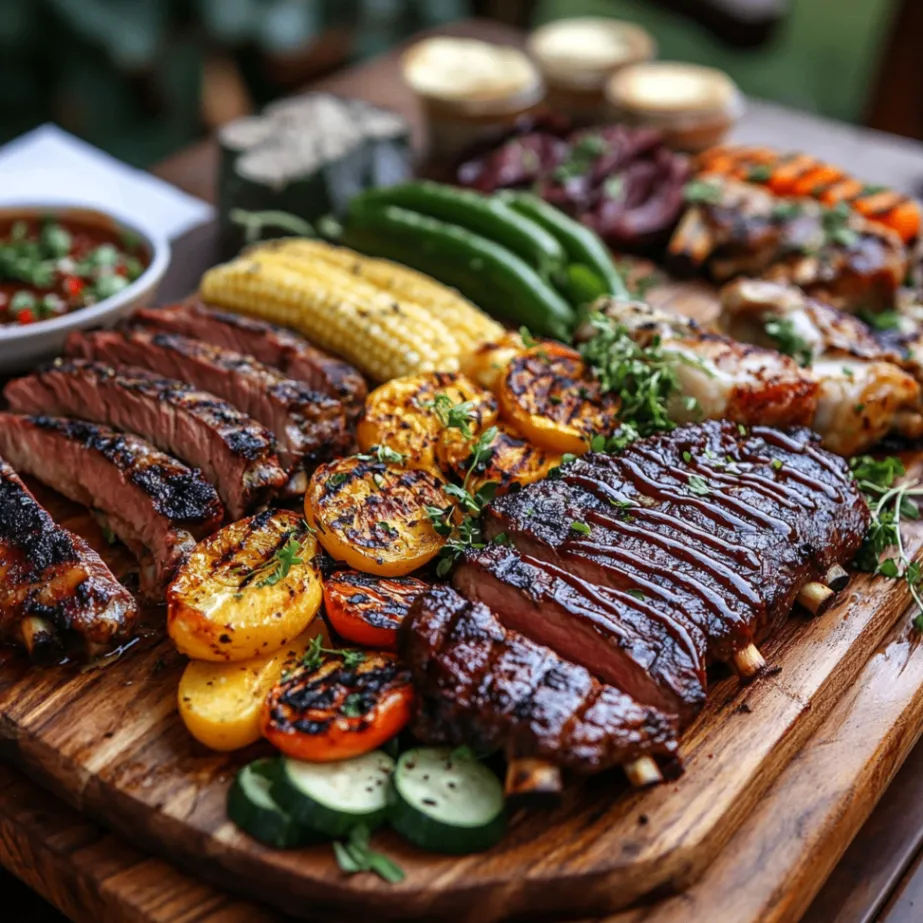
Ultimate BBQ Grilling Guide
Ingredients
Tried this recipe?
Let us know how it was!Essential Ingredients for the Perfect BBQ Feast
Premium Protein Selections
The foundation of any exceptional BBQ starts with choosing high-quality proteins that will shine on the grill. Here’s your complete protein shopping list:
Beef Options:
- 4-6 ribeye steaks (1-inch thick, well-marbled)
- 3 lbs beef brisket (with fat cap intact)
- 2 lbs ground chuck (80/20 blend for burgers)
- 2 lbs beef short ribs (English cut)
Pork Selections:
- 1 full rack baby back ribs (2-3 lbs)
- 2 lbs pork shoulder (for pulled pork)
- 8-10 Italian sausages
- 4 thick-cut pork chops (bone-in)
Poultry Choices:
- 1 whole chicken (3-4 lbs, spatchcocked)
- 8 chicken thighs (bone-in, skin-on)
- 4 chicken breasts (butterflied)
Seafood Options:
- 2 lbs large shrimp (16-20 count)
- 4 salmon fillets (6 oz each)
- 2 whole fish (snapper or trout)
Signature Dry Rub Blend
Create your own restaurant-quality dry rub with these carefully balanced spices:
- 1/4 cup brown sugar (adds caramelization)
- 2 tablespoons paprika (for color and mild heat)
- 2 tablespoons kosher salt (enhances natural flavors)
- 1 tablespoon black pepper (freshly ground)
- 1 tablespoon garlic powder
- 1 tablespoon onion powder
- 1 teaspoon cumin (adds earthiness)
- 1 teaspoon chili powder
- 1/2 teaspoon cayenne pepper (adjust to taste)
- 1/2 teaspoon dried oregano
- 1/2 teaspoon smoked paprika
Premium BBQ Sauce Components
For the ultimate homemade BBQ sauce that will have everyone asking for the recipe:
- 2 cups ketchup (high-quality base)
- 1/2 cup apple cider vinegar
- 1/4 cup brown sugar
- 2 tablespoons Worcestershire sauce
- 2 tablespoons yellow mustard
- 1 tablespoon molasses
- 1 teaspoon liquid smoke
- 1 teaspoon garlic powder
- 1/2 teaspoon onion powder
- Salt and pepper to taste
Fresh Vegetable Accompaniments
No BBQ is complete without perfectly grilled vegetables:
- 4 ears of corn (husks on)
- 2 large bell peppers (red and yellow)
- 2 zucchini (sliced lengthwise)
- 1 large red onion (thick slices)
- 2 cups cherry tomatoes
- 1 bunch asparagus
- 2 portobello mushroom caps
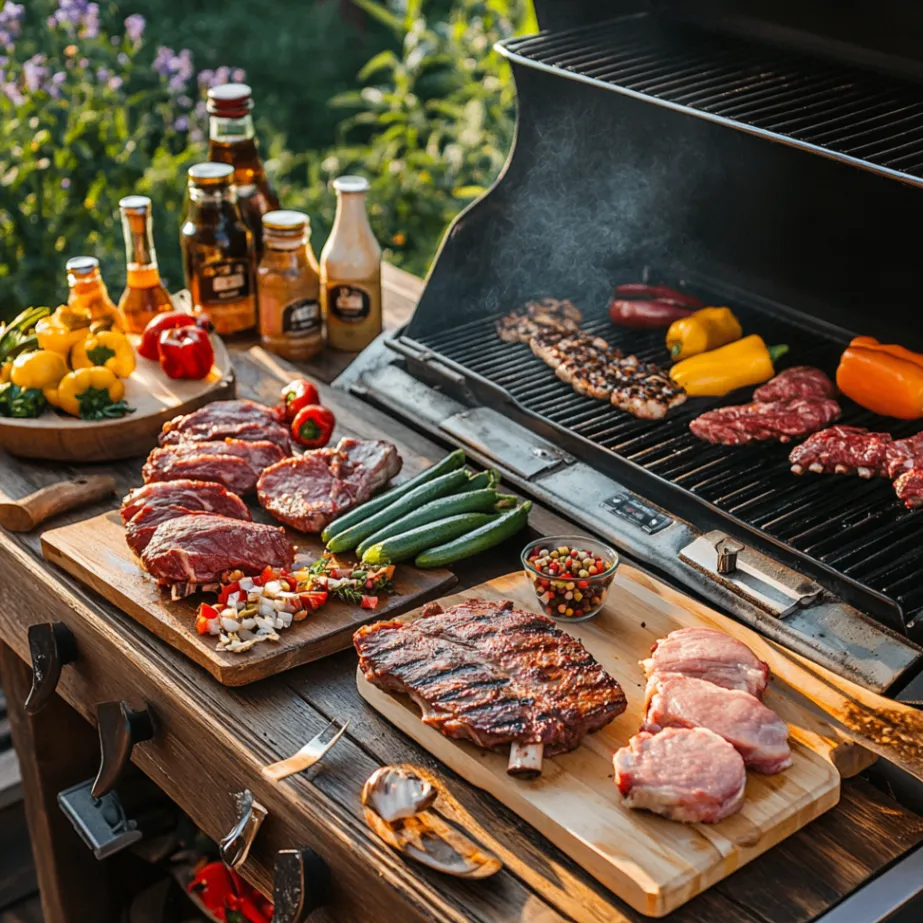
Step-by-Step BBQ Preparation Method
Phase 1: Pre-Grilling Preparation (2-4 Hours Before)
Step 1: Meat Preparation and Seasoning
Begin your BBQ journey by properly preparing your proteins. Remove all meats from refrigeration 30-45 minutes before cooking to allow them to reach room temperature, ensuring even cooking throughout. Pat each piece completely dry with paper towels—moisture is the enemy of proper searing and can prevent your dry rub from adhering properly.
Apply your signature dry rub generously to all surfaces of the meat, using your hands to massage the spices into every crevice. For larger cuts like brisket or pork shoulder, create a slightly thicker coating as these meats will benefit from more intense seasoning during their longer cooking time. Wrap seasoned meats in plastic wrap and refrigerate for at least 2 hours, though overnight marinating will produce even deeper flavors.
Step 2: Grill Setup and Fire Management
The success of your BBQ depends heavily on proper grill setup and temperature control. If using a charcoal grill, light your charcoal using a chimney starter—avoid lighter fluid which can impart unwanted chemical flavors to your food. Create different heat zones by banking coals to one side for direct high-heat cooking and leaving the other side cooler for indirect cooking.
For gas grills, preheat with all burners on high for 15 minutes, then adjust to create similar heat zones. Clean your grill grates thoroughly with a wire brush, then oil them lightly using a paper towel dipped in vegetable oil and held with long-handled tongs.
Step 3: Vegetable Preparation
While your grill heats up, prepare your vegetables for optimal grilling results. Leave corn in their husks but pull back the husks carefully, remove silk, then replace the husks—this creates a natural steaming environment. Cut bell peppers into large strips, slice zucchini lengthwise into 1/2-inch planks, and cut red onion into thick rounds, keeping rings intact with toothpicks if necessary.
Toss all vegetables except corn in olive oil, salt, and pepper. For extra flavor, add minced garlic and fresh herbs like rosemary or thyme to your vegetable oil mixture.
Phase 2: The Grilling Process
Step 4: Master the Art of Direct Grilling
Start with your fastest-cooking items first. Place steaks, chops, and chicken breasts over the hottest part of your grill. The key to perfect searing is patience—resist the urge to move or flip your proteins too early. You’ll know it’s time to flip when the meat releases easily from the grates, typically 4-6 minutes for steaks and 6-8 minutes for chicken breasts.
Use the “hand test” to gauge your grill’s temperature: hold your hand 5 inches above the grates and count how long you can keep it there. 2 seconds indicates high heat (450-500°F), 3-4 seconds is medium-high (400-450°F), and 5-6 seconds is medium (350-400°F).
Step 5: Perfect Your Indirect Cooking Technique
Move larger cuts like whole chickens, ribs, and roasts to the cooler side of your grill for indirect cooking. This method allows these proteins to cook through evenly without burning the exterior. Maintain your grill temperature between 225-250°F for traditional low-and-slow BBQ, or 325-350°F for faster indirect cooking.
For added flavor, create a smoke packet by wrapping soaked wood chips (hickory, apple, or cherry work beautifully) in heavy-duty aluminum foil, poking holes in the top, and placing it directly on your heat source.
Step 6: Vegetable Grilling Excellence
Vegetables require different timing and techniques for optimal results. Start with denser vegetables like corn and thick onion slices, which need 12-15 minutes total cooking time. Add bell peppers and zucchini after 5-7 minutes, as they cook faster and can become mushy if overcooked.
Asparagus and cherry tomatoes should be added last, requiring only 3-5 minutes of direct heat. Turn vegetables frequently to ensure even charring and prevent burning.
Phase 3: Final Assembly and Serving
Step 7: Rest and Finish Your Proteins
Proper resting is crucial for juicy, flavorful results. Remove steaks and chops from the grill when they reach 5°F below your target doneness temperature—they’ll continue cooking during the resting period. Tent loosely with foil and let rest for 5-10 minutes for individual cuts, or 15-20 minutes for larger roasts.
During this resting time, brush your homemade BBQ sauce on ribs and chicken during the last few minutes of cooking, allowing it to caramelize without burning.
Step 8: Create Your BBQ Presentation
Arrange your perfectly grilled proteins and vegetables on large platters, garnishing with fresh herbs like chopped parsley, cilantro, or green onions. Serve additional BBQ sauce on the side in small bowls, and don’t forget to provide plenty of napkins—the best BBQ is always a little messy!
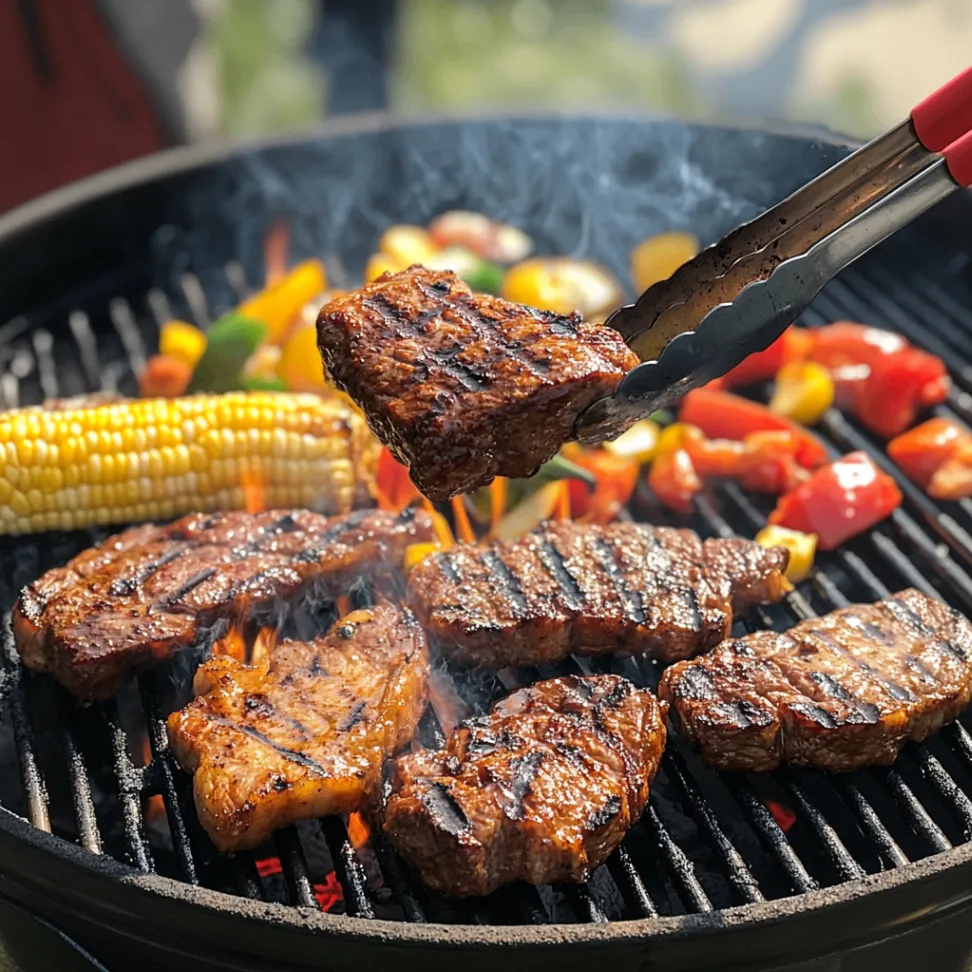
Professional Grilling Tips and Techniques
Temperature Control Mastery
Understanding and controlling temperature is perhaps the most critical skill in successful grilling. Invest in a reliable instant-read thermometer and learn the target temperatures for different proteins: 125°F for rare beef, 135°F for medium-rare, 145°F for pork and fish, and 165°F for poultry.
Create and maintain different temperature zones on your grill by arranging coals or adjusting gas burners. This allows you to sear proteins over high heat, then move them to moderate heat to finish cooking without burning.
The Science of Marinades and Rubs
Marinades work differently than dry rubs—acidic ingredients like vinegar, citrus juice, or wine help tenderize tougher cuts while infusing flavor. However, don’t marinate delicate proteins like fish for more than 30 minutes, as the acid can actually “cook” the flesh, creating a mushy texture.
Dry rubs, on the other hand, create a flavorful crust while drawing out moisture initially, then reabsorbing those concentrated flavors. For best results, apply rubs at least 40 minutes before cooking, though several hours or overnight is even better for larger cuts.
Wood Selection for Smoking
Different woods impart distinct flavors to your grilled foods. Fruit woods like apple and cherry provide mild, sweet smoke perfect for poultry and pork. Hickory delivers a strong, bacon-like flavor ideal for beef and pork. Oak offers a medium smokiness that complements almost any protein, while mesquite provides intense flavor that works well with beef but can overpower delicate foods.
Soak wood chips for 30 minutes before using to create more smoke and prevent them from burning too quickly. For longer smoking sessions, consider using wood chunks instead of chips for more sustained smoke production.
Advanced Grilling Techniques
Reverse Searing: Start thick steaks or chops on the cooler side of your grill, cooking them slowly until they reach 10°F below your target temperature, then finish with a high-heat sear for perfect edge-to-edge doneness.
Spatchcocking: Remove the backbone from whole chickens or turkeys and flatten them completely. This technique reduces cooking time by up to 50% while ensuring even cooking and crispy skin.
Beer Can Chicken: While controversial among some pitmasters, this method can produce incredibly moist results. Use a half-full can of beer inserted into the chicken’s cavity, creating steam while the bird cooks upright.
Creating the Perfect BBQ Atmosphere
Setting Up Your Outdoor Kitchen
Transform your backyard into an efficient outdoor cooking space by organizing your tools and ingredients before you begin cooking. Set up stations for raw foods, cooked foods, and utensils, ensuring you never cross-contaminate. Have a spray bottle filled with water nearby for flare-up control, and keep a clean platter ready for finished foods.
Consider the wind direction when positioning your grill—you want smoke blowing away from your guests, not toward your seating area. Adequate lighting is essential for evening grilling, so invest in good outdoor lighting or keep a flashlight handy.
Music, Ambiance, and Entertainment
Create playlist that matches your BBQ’s vibe—whether that’s classic rock, country, jazz, or reggae. Keep the volume at a level that encourages conversation rather than overwhelming it. String lights, tiki torches, or lanterns can create a warm, inviting atmosphere as the sun sets.
Set up lawn games like cornhole, horseshoes, or giant Jenga to keep guests entertained while you tend the grill. Having activities available prevents everyone from crowding around the cooking area and gives you space to work your magic.
 DINNER
DINNER  LUNCH
LUNCH  Desserts
Desserts  BREAKFAST
BREAKFAST For more amazing recipes, be sure to check out our other sections to explore a variety of ideas that will enrich your cooking experience. Each section offers its own unique flavors to ensure a delightful culinary journey:
Easy and Quick Recipes: A collection of dishes that guarantee delicious meals with minimal effort and time.
Healthy Recipes: Discover healthy and delicious options that fit your lifestyle.
Desserts: A diverse selection of sweets that will add a special touch of sweetness to your table.
Lunch Recipes: Tasty lunch ideas that you can easily prepare to delight your family.
Dinner Recipes: Delicious and easy-to-make recipes that will make your dinner a memorable occasion.
Frequently Asked Questions
How do I prevent my meat from sticking to the grill grates?
The key to preventing sticking is proper grill preparation and patience. Ensure your grill grates are completely clean and well-oiled before cooking. Preheat your grill adequately—most sticking occurs on insufficiently heated grates. Most importantly, don’t try to flip or move your protein too early. When properly seared, meat will naturally release from the grates.
What’s the difference between grilling and barbecuing?
Grilling typically involves cooking over direct heat at higher temperatures (300-500°F) for shorter periods, perfect for steaks, burgers, and vegetables. Barbecuing refers to low-and-slow cooking (225-275°F) over indirect heat for extended periods, ideal for tough cuts like brisket, ribs, and pork shoulder that need time to break down connective tissues.
How can I tell when my meat is done without cutting into it?
Invest in a reliable instant-read thermometer—it’s the most accurate method for determining doneness. Learn to recognize the feel test: press the center of your protein with your finger. Rare meat feels soft and squishy, medium feels like the flesh between your thumb and forefinger when you make an “OK” sign, and well-done feels firm like the muscle at the base of your thumb when pressed against your pinky.
Why do my burgers always fall apart on the grill?
Burger integrity starts with proper meat selection—use ground chuck with 80/20 fat content for the best balance of flavor and binding. Don’t overmix your meat when forming patties, and create a slight indentation in the center of each patty to prevent puffing. Most importantly, flip only once and resist pressing down with your spatula, which squeezes out flavorful juices.
How do I maintain consistent temperature on my grill?
For charcoal grills, learn to manage your airflow—opening vents increases temperature while closing them decreases it. Add fresh charcoal gradually rather than all at once to maintain steady heat. For gas grills, use indirect cooking methods and avoid constantly opening the lid, which releases heat. Consider investing in a grill thermometer if your grill doesn’t have a reliable built-in gauge.
What should I do if I get flare-ups?
Flare-ups are caused by fat dripping onto hot coals or burners. Move your food to a cooler part of the grill temporarily and let the flames die down naturally. Keep a spray bottle with water nearby for emergencies, but use it sparingly as too much water can create steam and affect cooking. Trim excess fat from meats before grilling to minimize flare-ups.
How long should I let my meat rest after grilling?
Resting allows juices to redistribute throughout the meat, resulting in more tender, flavorful results. Rest steaks and chops for 5-10 minutes, larger roasts for 15-20 minutes, and whole birds for 10-15 minutes. Tent loosely with foil to keep warm, but don’t wrap tightly as this can make crispy skin soggy.
Can I prepare anything ahead of time for a BBQ party?
Absolutely! Prepare your dry rubs and marinades up to 24 hours in advance. Marinate proteins the night before, and prep vegetables earlier in the day. Make your BBQ sauce up to a week ahead—the flavors actually improve over time. Set up your grill station with all tools and supplies before guests arrive, allowing you to focus on cooking and socializing.
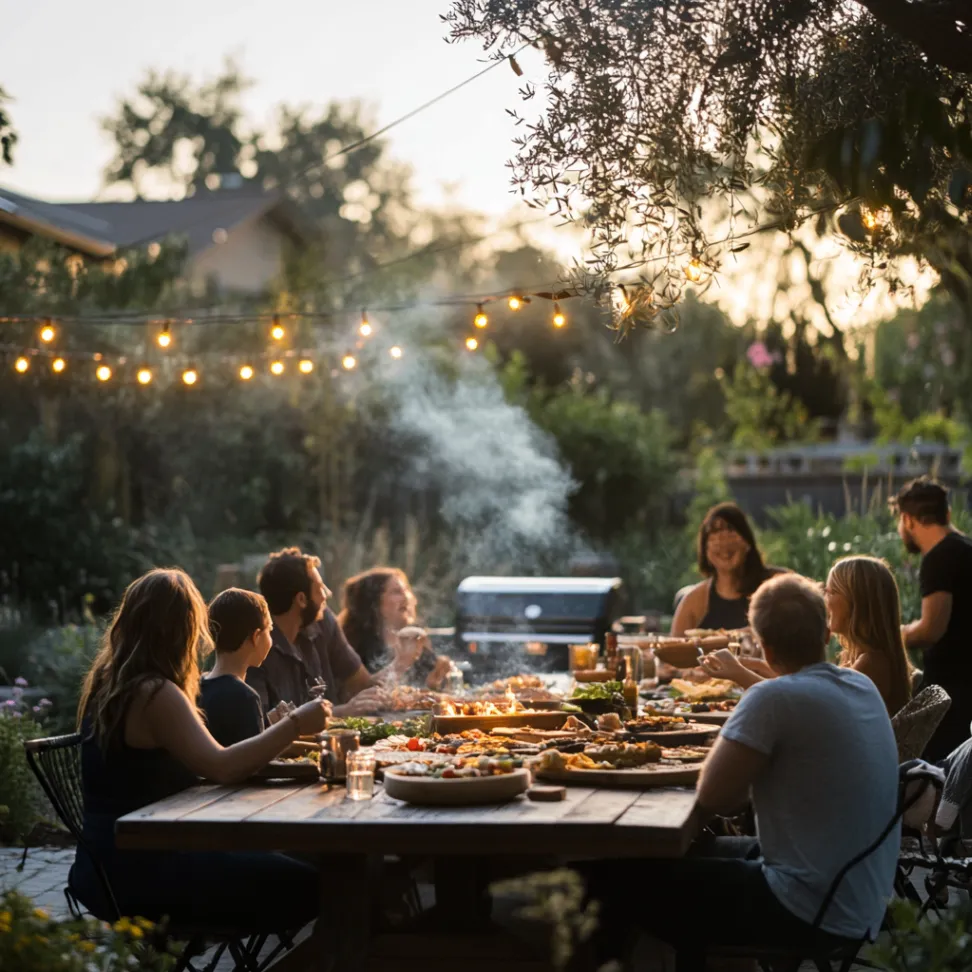
Summary: Mastering the Art of BBQ Excellence
Creating the perfect BBQ experience combines technical skill, quality ingredients, and thoughtful preparation with the joy of bringing people together around exceptional food. From selecting premium cuts of meat and understanding the science behind marinades and rubs to mastering temperature control and creating the perfect outdoor ambiance, every element contributes to an unforgettable gathering.
The techniques outlined in this comprehensive guide will transform your backyard cooking from simple grilling to true BBQ artistry. Remember that great BBQ isn’t just about the food—it’s about creating an atmosphere where friends and family can connect, laugh, and create lasting memories around the universal pleasure of sharing a perfectly prepared meal.
Whether you’re hosting an intimate family dinner or a large celebration, these professional techniques and insider tips will ensure your BBQ becomes the highlight of any gathering. The combination of properly seasoned proteins, perfectly grilled vegetables, and the warm ambiance of outdoor cooking creates an experience that goes far beyond mere sustenance.
Start with quality ingredients, master your temperature control, embrace the patience required for true BBQ excellence, and most importantly, enjoy the process. The best BBQ experiences happen when the cook is relaxed and having fun—that positive energy transfers to your guests and becomes part of the meal itself.
With practice and attention to detail, you’ll develop the confidence and skills to create BBQ experiences that will have your guests talking long after the last ember has cooled. Fire up your grill, gather your favorite people, and start creating the kind of memories that only come from sharing exceptional food in great company
